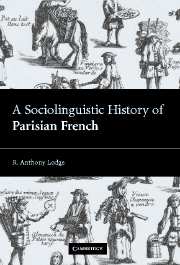Book contents
- Frontmatter
- Contents
- List of maps
- List of tables
- List of figures
- Acknowledgments
- List of phonetic symbols
- Part 1 Preliminaries
- Introduction
- 1 ‘The French of Paris’
- 2 The analytical frame
- Part 2 The pre-industrial city
- Part 3 The proto-industrial city
- Part 4 The industrial city
- Conclusion
- Appendix Literary imitations of low-class speech
- Bibliography
- Index
2 - The analytical frame
Published online by Cambridge University Press: 22 September 2009
- Frontmatter
- Contents
- List of maps
- List of tables
- List of figures
- Acknowledgments
- List of phonetic symbols
- Part 1 Preliminaries
- Introduction
- 1 ‘The French of Paris’
- 2 The analytical frame
- Part 2 The pre-industrial city
- Part 3 The proto-industrial city
- Part 4 The industrial city
- Conclusion
- Appendix Literary imitations of low-class speech
- Bibliography
- Index
Summary
The desirability of a multidimensional approach to linguistic history is easy enough to argue nowadays. What is nothing like so easy is to find the data which would make such a study possible. This chapter must begin with the central and most intractable problem in the book: that of evidence. We will set out the main types of data available in the different periods of Parisian French, with for ever at the back of our mind the basic uncertainty over whether historical sociolinguistics is possible at all (§ 2.1). In the second and third parts we will look at general factors in urban history and dialect development which will help us limit the range of constructions we can place upon our very imperfect data-base. Since language and society are inextricably entwined, any patterns we detect in urban dialect development must be compatible with the patterns identified by urban historians in the development of European cities over the relevant period (§ 2.2). Furthermore, whatever patterns we see in the past must be broadly in line with the insights derived by modern dialectologists from analogous, and infinitely better documented, linguistic situations in the contemporary world. The ‘uniformitarian principle’ is no panacea, but it may be possible to project backwards to obtain a better understanding of earlier stages of the French language (§ 2.3). All of this will be incorporated into the general analytical frame which we will set out in the concluding paragraph and which will structure the rest of the book.
- Type
- Chapter
- Information
- A Sociolinguistic History of Parisian French , pp. 17 - 34Publisher: Cambridge University PressPrint publication year: 2004

